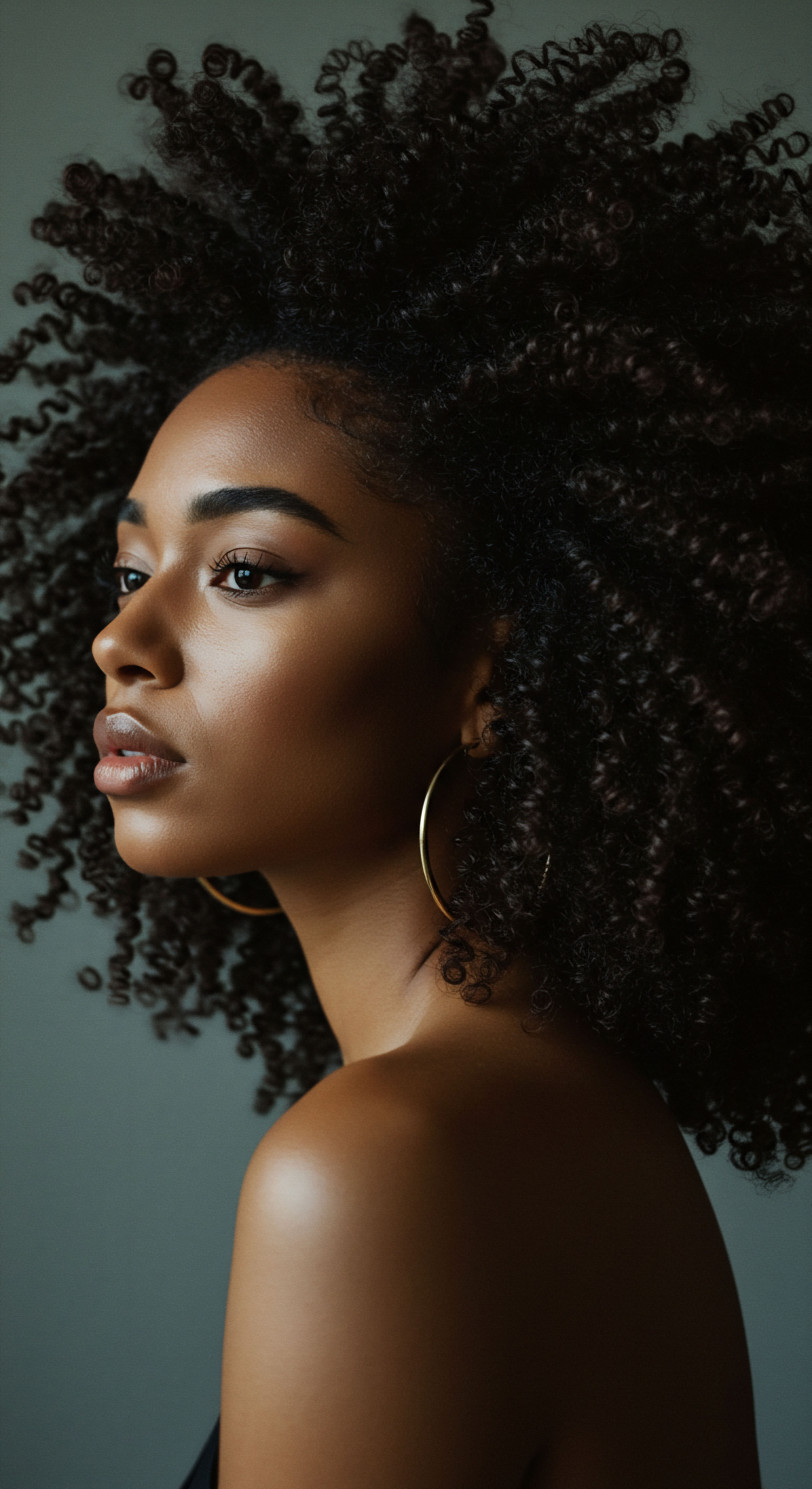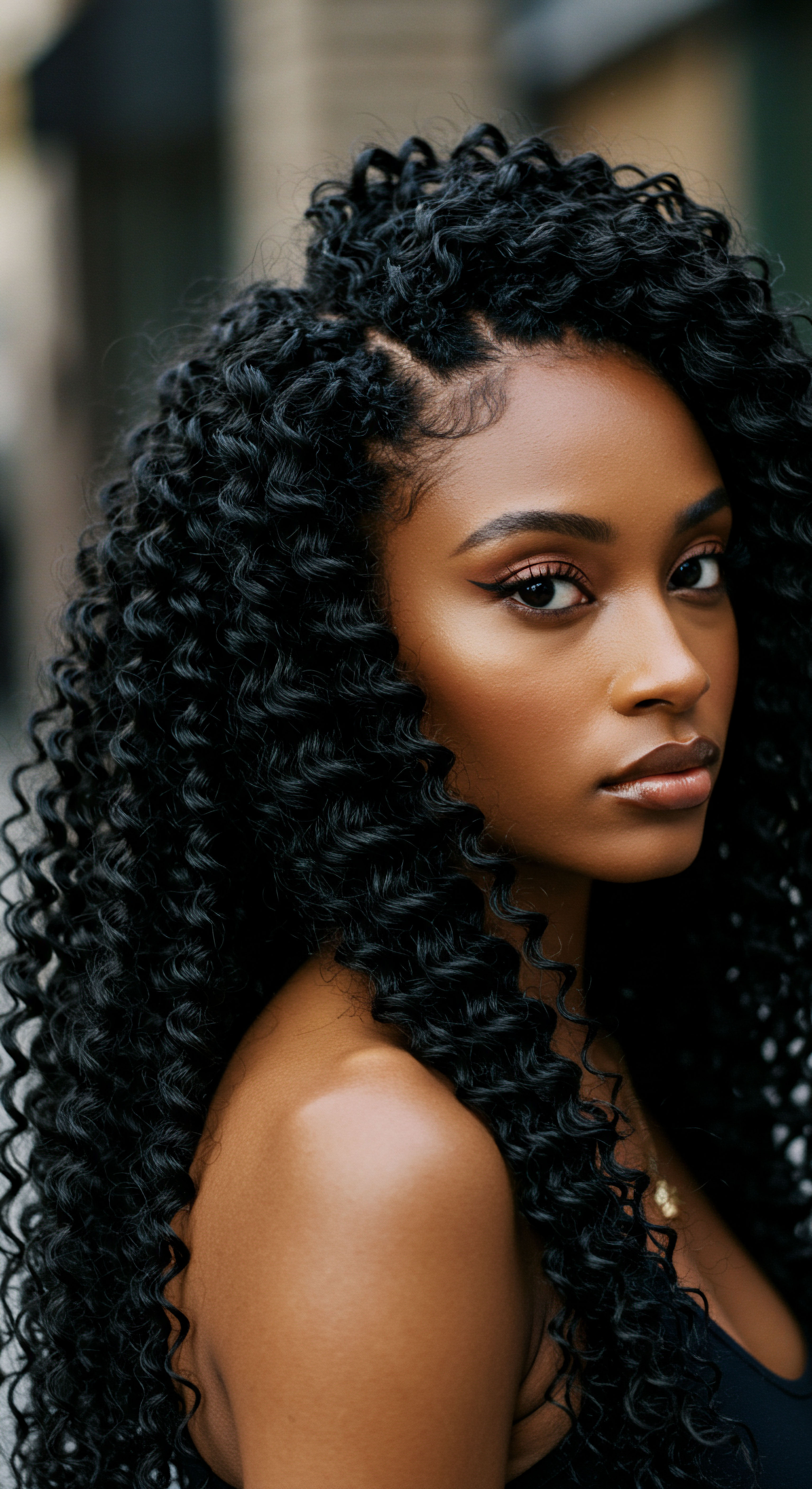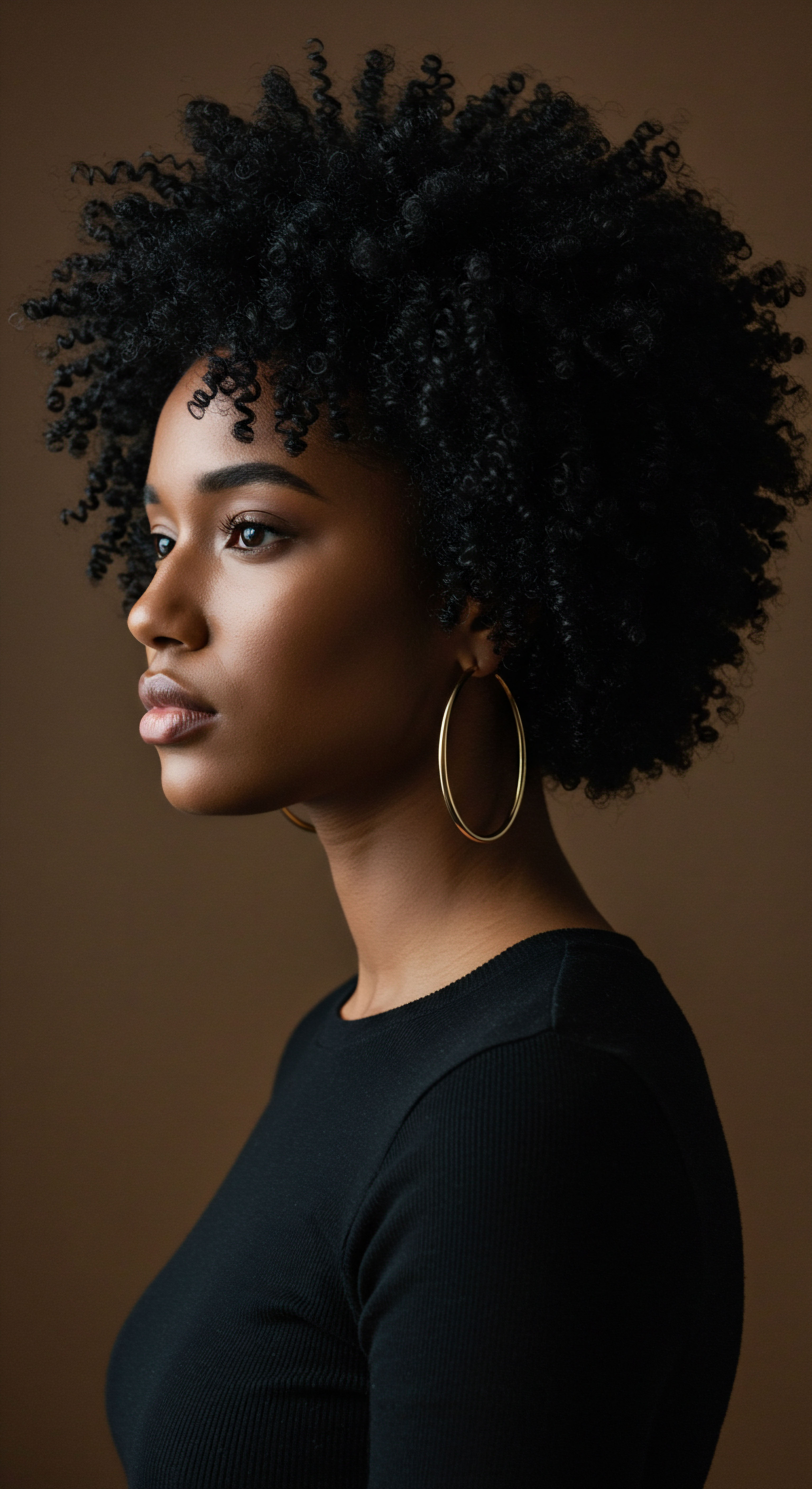
Roots
The quiet observation of our own physical being, the subtle shifts and gentle cycles that guide us through each day and season, often brings us to a profound understanding. How, then, do the cherished customs of our forebears, those delicate acts of hair care passed down through generations, intertwine with these intrinsic bodily rhythms? This exploration begins at the very root, considering hair not as a mere adornment, but as a living extension of our deepest selves, responsive to the whispers of our internal world.
Across countless cultures, hair has held a place of singular reverence, a visible chronicle of life’s passage and an antenna for the unseen energies around us. Our ancestors, keenly attuned to the rhythms of the earth and sky, perceived a reciprocal dance between the external world and the internal workings of the body. They understood that the sun’s ascent and descent, the moon’s waxing and waning, and the shifting seasons all held sway over life, including the very strands that crowned their heads. This awareness informed their daily rituals, creating a continuum where personal care became a dialogue with nature’s grand design.

Hair’s Connection to Circadian Cadences
The human body operates on a remarkable internal clock, a circadian rhythm that orchestrates nearly every physiological process, from sleep and wakefulness to hormone release and cellular regeneration. Our hair follicles, these tiny organs embedded in the scalp, are not exempt from this intricate temporal choreography. They possess their own molecular clocks, influencing the precise timing of hair growth, rest, and shedding. A follicle, like a miniature orchestra, plays its part in a daily symphony, its performance influenced by the broader conductor of the body’s internal clock.
Ancient traditions, while lacking modern scientific vocabulary, often intuitively aligned with these natural cadences. The timing of hair cleansing, oiling, or styling was not arbitrary; it frequently corresponded with moments of rest or activity, periods of deep cleansing, or times of heightened receptivity. Consider the practice of night-time oiling, common in many ancestral regimens.
This ritual, performed before sleep, aligns with the body’s period of repair and regeneration, allowing nourishing oils to penetrate and support the hair follicle during its nocturnal restorative work. This thoughtful timing, whether consciously linked to circadian science or simply observed for its beneficial outcome, highlights a deep, inherited wisdom.
Ancestral hair practices often mirror the body’s inherent temporal patterns, aligning care with natural rhythms of growth and renewal.

Seasonal Shifts and Hair’s Response
Beyond the daily rhythm, the grander cycles of the seasons also leave their mark on our hair. Many observe seasonal shedding, a natural phenomenon where hair loss may increase during certain times of the year, often linked to changes in light exposure and hormonal fluctuations. Ancestral communities, living intimately with the land, would have noticed these seasonal variations in hair density and vitality. Their practices adapted accordingly.
- Seasonal Cleansing Rituals ❉ Some traditions emphasized deep cleansing or clarifying hair treatments during periods of transition, like spring, to prepare the scalp for new growth.
- Protective Styles for Climate ❉ Styles that offered protection from harsh summer sun or biting winter winds were adopted, shielding strands from environmental stressors that could disrupt hair health.
- Harvesting Local Botanicals ❉ The use of plant-based remedies for hair care often coincided with the seasonal availability of those plants, ensuring freshness and potency.
This attunement to seasonal shifts speaks to a holistic view of well-being, where hair health was inextricably bound to the environment and the body’s adaptive responses to it. It was a dance of responsiveness, where human hands worked in concert with nature’s unfolding calendar.

Ritual
As we move from foundational understanding to applied wisdom, how do these ancestral hair traditions translate into the tangible acts of ritual, shaping our very experience of care? The transition from abstract knowledge to daily practice reveals a deeper dimension, where each gesture, each ingredient chosen, carried purpose beyond mere function. These practices were not simply routines; they were deliberate, often sacred, engagements with the self and the world, influencing our internal state and, by extension, our physical being.
Ancestral hair care rituals were deeply personal, yet often communal, affairs. They involved specific timings, dedicated spaces, and often, the sharing of knowledge and touch. This communal aspect, the act of tending to one another’s hair, fostered connection and belonging, elements known to significantly influence our emotional and physiological well-being. The gentle handling of strands, the rhythmic strokes of a comb, the application of nourishing preparations – these actions, repeated over time, created a meditative quality, a quiet space for introspection and connection.

Cleansing Rhythms and Bodily Purification
The act of cleansing hair, far from being a simple wash, often carried symbolic weight, representing purification and renewal. In many traditions, certain days were designated for hair washing, perhaps aligning with lunar cycles or specific phases of life. The choice of cleansing agents – natural clays, saponified plant extracts, or fermented rinses – reflected an understanding of what the body and hair needed to release and absorb. These practices, while outwardly focused on hair, simultaneously addressed the body’s internal state, promoting a sense of lightness and clarity.
For instance, the tradition of using rhassoul clay for cleansing, prevalent in North African cultures, goes beyond surface cleaning. This mineral-rich clay, when applied to hair and skin, not only cleanses but also absorbs impurities and toxins, drawing them from the body. This process aligns with the body’s natural detoxification pathways, which are more active during certain periods of rest or specific dietary cycles. The ritualistic application of such natural elements served as a gentle support for the body’s inherent purification processes, contributing to overall vitality.

Oiling and Nourishment as Sustenance
Oiling hair was, and remains, a cornerstone of many ancestral practices. This ritual of anointing the scalp and strands with nutrient-rich oils served multiple purposes ❉ protection, conditioning, and a profound act of self-care. The choice of oils—coconut, argan, olive, or specific herbal infusions—was often dictated by local flora, seasonal availability, and an intuitive understanding of their properties.
The application of oils, particularly with a scalp massage , directly influences bodily rhythms. A study by Kim et al. (2018) in the International Journal of Dermatology demonstrated that regular scalp massage can lead to increased hair thickness by mechanically stretching hair follicle cells and improving blood flow.
This physical stimulation, a central element of many ancestral oiling rituals, promotes circulation to the scalp, ensuring that follicles receive the vital nutrients needed for healthy growth cycles. This quiet, rhythmic touch, deeply calming to the nervous system, offers a tangible connection between ancestral practice and measurable physiological benefit.
The rhythmic application of nourishing oils and gentle scalp massage in ancestral traditions actively supports scalp health and influences hair vitality.

Protective Styles and Their Physiological Role
Protective styles, such as braids, twists, and locs, are not merely aesthetic choices; they are deeply practical and historically significant. These styles shielded hair from environmental damage, minimized manipulation, and promoted length retention. But their connection to bodily rhythms runs deeper. The act of creating and maintaining these styles often involved periods of stillness and focus, almost a meditative state for both the stylist and the recipient.
Furthermore, the tension and weight distribution of certain protective styles could subtly influence blood circulation on the scalp, or even provide a gentle, continuous stimulation. The communal gathering for braiding sessions, for example, would reduce stress through social connection and shared activity, indirectly supporting hormonal balance and overall well-being, which directly impacts hair health. This holistic approach recognized that the external presentation of hair was a reflection of internal harmony.

Relay
Moving into a more sophisticated understanding, how do ancestral hair traditions, seemingly simple acts, serve as a profound relay for the intricate interplay of biological, psychological, and cultural factors that shape our bodily rhythms? This deeper inquiry invites us to consider hair not just as a physical entity, but as a dynamic participant in our internal landscape, a silent witness to our health, our stress, and our very genetic story. Here, science and ancient wisdom find common ground, revealing layers of connection often overlooked.

Epigenetics and Intergenerational Hair Wisdom
The emerging field of epigenetics offers a fascinating lens through which to view ancestral hair traditions. Epigenetics explores how environmental factors and lifestyle choices can influence gene expression without altering the underlying DNA sequence. While our genes provide the blueprint for our hair type and texture, external influences—including diet, stress, and even the very rituals passed down through families—can affect how those genes are expressed.
Consider the dietary habits associated with traditional hair care. Many ancestral communities consumed diets rich in specific vitamins, minerals, and healthy fats, derived from local, seasonal foods. These nutritional choices, passed down through generations, would have provided the essential building blocks for healthy hair growth, influencing the expression of genes related to keratin production and follicle vitality. The consistency of these practices across generations might have created a positive epigenetic feedback loop, supporting robust hair health that transcended individual lifetimes.
| Ancestral Practice Herbal Rinses |
| Biological Impact Scalp microbiome balance, anti-inflammatory properties |
| Potential Epigenetic Link Influences gene expression related to skin immunity and cellular repair. |
| Ancestral Practice Nutrient-Rich Diet |
| Biological Impact Provides essential vitamins, minerals, proteins |
| Potential Epigenetic Link Directly impacts gene expression for keratin synthesis and follicle health. |
| Ancestral Practice Stress-Reducing Rituals |
| Biological Impact Lowers cortisol levels, promotes relaxation |
| Potential Epigenetic Link Modulates gene expression associated with stress response and cellular aging. |

The Psychoneuroimmunology of Hair Care Rituals
Our hair’s condition is deeply intertwined with our psychological and neurological states. The field of psychoneuroimmunology explores the intricate communication network between the brain, the endocrine system, and the immune system. Stress, anxiety, and emotional distress can significantly impact hair health, often leading to increased shedding or changes in growth patterns. This is where the rhythmic, often calming, nature of ancestral hair rituals reveals its profound depth.
The repetitive, gentle motions of oiling, braiding, or detangling can induce a meditative state, activating the parasympathetic nervous system—our “rest and digest” mode. This activation reduces the production of stress hormones like cortisol, which are known to prematurely push hair follicles into a resting phase, leading to hair loss. By fostering a sense of calm and well-being, these rituals inadvertently supported the optimal functioning of the hair growth cycle, aligning it with the body’s natural state of equilibrium.
The soothing repetition of ancestral hair rituals can quiet the nervous system, mitigating stress’s adverse effects on hair growth cycles.

Hair as a Biomarker for Internal Health and Rhythms
Hair strands themselves serve as remarkable biological archives, capable of storing information about our internal environment over time. Hair analysis can reveal long-term exposure to certain minerals, toxins, and even stress hormones. This capacity of hair to record physiological states underscores its deep connection to bodily rhythms.
Ancestral healers, though without laboratory equipment, possessed an intuitive understanding of hair as a diagnostic tool. Changes in hair texture, luster, or density might have signaled shifts in internal health, diet, or emotional well-being. A sudden dullness, excessive shedding, or altered curl pattern could indicate an imbalance in the body’s internal harmony, perhaps a disruption in its natural rhythms due to illness, nutritional deficiency, or prolonged stress. This ancient observation finds resonance in modern science, where hair cortisol analysis is used to assess chronic stress levels, offering a window into the body’s long-term stress response and its impact on various systems, including hair growth.

How Do Cultural Hair Practices Inform Our Understanding of Wellness?
The diverse tapestry of global hair traditions offers a rich repository of insights into human wellness. In many indigenous cultures, hair is considered a sacred conduit, connecting individuals to their lineage, their community, and the spiritual realm. The care of hair was therefore a spiritual practice, a means of maintaining balance not just within the individual, but within the collective. These practices often aligned with the rhythms of the community, the lunar calendar, or agricultural cycles, reinforcing a sense of interconnectedness.
For example, in some African traditions, hair was styled to reflect social status, age, or significant life events, creating a visible language of identity. The meticulous care involved in these styles, often taking hours or even days, became a shared experience, strengthening social bonds and reducing individual isolation—a known contributor to stress and physiological imbalance. The deep respect for hair in these contexts underscores a belief in its intrinsic connection to the wearer’s vitality and their place within the broader rhythms of life.

Reflection
The gentle hum of our own being, the subtle pulse of life within us, finds a quiet echo in the ancient traditions that shaped the care of our hair. To consider ancestral hair practices is to peer into a profound wisdom, a way of living deeply attuned to the rhythms of the body and the earth. These are not merely historical footnotes; they are living testaments to an understanding that hair is not separate from us, but an extension of our internal landscape, responsive to our well-being, our environment, and the timeless cadences that guide all life. As we rediscover these inherited ways, we find not just secrets for healthy hair, but pathways to a more harmonious existence, where every strand tells a story of connection.

References
- Kim, J. et al. (2018). Standardized Scalp Massage Results in Increased Hair Thickness by Inducing Stretching Forces to Dermal Papilla Cells in the Human Hair Follicle. International Journal of Dermatology, 57(5), 612-616.
- Paus, R. & Cotsarelis, G. (2009). The Biology of Hair Follicles. New England Journal of Medicine, 361(19), 1892-1901.
- McEwen, B. S. (1998). Stress, Adaptation, and Disease ❉ Allostasis and Allostatic Load. Annals of the New York Academy of Sciences, 840(1), 33-44.
- Heschong, L. & Wright, L. (2002). Daylighting and Human Performance. Heschong Mahone Group.
- Kligman, A. M. (1959). The Human Hair Cycle. Journal of Investigative Dermatology, 33(6), 307-311.
- Rushton, D. H. (2002). Nutritional Factors and Hair Loss. Clinical and Experimental Dermatology, 27(5), 396-404.